View in other NatureServe Network Field Guides
NatureServe
Montana
Utah
Wyoming
Idaho
Wisconsin
British Columbia
South Carolina
Yukon
California
New York
Red Knot - Calidris canutus
General Description
Rarely observed at Montana wetlands during migration in May or July through October (Montana Natural Heritage Program Point Observation Database 2016). The Red Knot is a medium-sized, bulky sandpiper about 23-25 cm in total length (Baker et al. 2013). Breeding plumage is a salmon-red to brick-red color (often slightly faded) with a light-colored lower belly and under tail covert region; back and tail feathers are generally dark gray with light terminal edges and subterminal rust-colored spots (Harrington 2001; Sibley 2014).
For a comprehensive review of the conservation status, habitat use, and ecology of this and other Montana bird species, please see
Marks et al. 2016, Birds of Montana.Diagnostic Characteristics
The Red Knot’s distinctive reddish plumage makes it easily recognizable during the breeding season. The Red Knot differs from dowitchers (Limnodromus spp.) in its shorter bill, paler crown, and whitish rump barred with grey. It may also be confused with Dunlins (Calidris alpina), which are smaller than Red Knots and have proportionately longer bills with a down-curve at the tip. (Baker et al. 2013)
Species Range
Uncommon Migrant
Western Hemisphere Range

Observations in Montana Natural Heritage Program Database
Number of Observations: 73
(Click on the following maps and charts to see full sized version)
Map Help and Descriptions
Relative Density
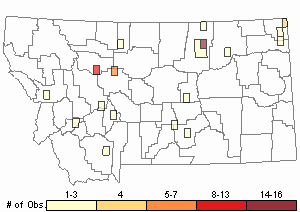
Recency
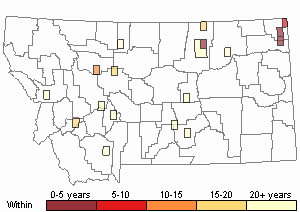
SUMMER (Feb 16 - Dec 14)
Direct Evidence of Breeding

Indirect Evidence of Breeding

No Evidence of Breeding

WINTER (Dec 15 - Feb 15)
Regularly Observed

Not Regularly Observed

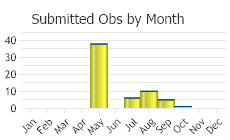
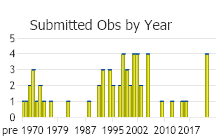
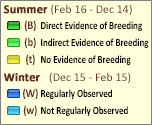 (Observations spanning multiple months or years are excluded from time charts)
(Observations spanning multiple months or years are excluded from time charts)
Migration
Annually migrate between arctic tundra breeding grounds and marine wintering habitats as far south as Tierra del Fuego, an annual migration distance of up to 30,000 km (Baker et al. 2013). Newstead et al. (2013) used geolocation to show that Red Knots wintering along the Texas coast used the Central Flyway on both north- and south-bound migrations, and used stopover sites in the Northern Great Plains of the US and Canada and also the Nelson River Delta/Hudson Bay area. There are only ca. 50 observations documented for individuals stopping at Montana wetlands, with only 0-4 for any given year since the 1970s; 60 percent of observations have been in May associated with northward migration (Montana Natural Heritage Program Point Observation Database 2016).
Habitat
Migratory stopovers in Montana are rare, but are most common at larger wetlands and 60 percent of documented migratory stopovers in Montana have been at Freezeout Lake, Benton Lake National Wildlife Refuge, and Lake Bowdoin National Wildlife Refuge (Montana Natural Heritage Program Point Observation Database 2016).
Food Habits
Invertebrates are Red Knots’ major food items away from breeding grounds, particularly small mollusks, but also crustaceans and insects. During the early breeding season, and occasionally during migration, knots will eat plant foods, although they generally use animal foods for most of the year (Baker et al. 2013).
Ecology
Red Knots generally forage and roost in flocks, both on and away from breeding grounds. Flocks are largest at migration staging and wintering areas. (Baker et al. 2013)
Reproductive Characteristics
Red Knots arrive in arctic breeding areas in late May-early June. Pairs are monogamous. Only one brood per season is known; clutch size is usually four eggs. (Baker et al. 2013)
Management
The U.S. Fish and Wildlife Service listed the rufa Red Knot (
C. canutus rufa) as Threatened on January 12th, 2015 due to loss of breeding and nonbreeding habitat, disruption of natural predator cycles on breeding grounds, reduced prey availability throughout the nonbreeding range, and increasing frequency and severity of mismatches in the timing of the birds' annual migratory cycle relative to favorable food and weather conditions (Federal Register 79(238):73706-73748). Migratory stopovers in Montana have been rare at wetlands scattered across the state, but 60 percent of documented stopovers have been at Freezeout Lake, Benton Lake National Wildlife Refuge, and Lake Bowdoin National Wildlife Refuge (Montana Natural Program Point Observation Database 2014). Protection of these and other wetlands, especially larger wetlands rich with invertebrate prey, is of value to this rarely documented visitor as well as other migratory and nonmigratory species (Harrington 2001).
Additional information on the biology and management of Red Knot populations can be found on the U.S. Fish and Wildlife Service's
Environmental Conservation Online System Species ProfileStewardship Responsibility
References
- Literature Cited AboveLegend:
 View Online Publication
View Online Publication Baker, A.P. Gonzalez, R.I.G. Morrison and B.A. Harrington. 2013. Red Knot (Calidris canutus), The Birds of North America Online (A. Poole, Ed.). Ithaca: Cornell Lab of Ornithology; Retrieved from the Birds of North America Online: http://bna.birds.cornell.edu/bna/species/563. (Accessed 14 March 2016.)
Baker, A.P. Gonzalez, R.I.G. Morrison and B.A. Harrington. 2013. Red Knot (Calidris canutus), The Birds of North America Online (A. Poole, Ed.). Ithaca: Cornell Lab of Ornithology; Retrieved from the Birds of North America Online: http://bna.birds.cornell.edu/bna/species/563. (Accessed 14 March 2016.) Harrington, B. A. 2001. Red Knot (Calidris canutus). In The birds of North America, No. 563 (A. Poole and F. Gill, Eds.). Academy of Natural Sciences of Philadelphia and American Ornithologists’ Union. [Revised online 8 November 2013]
Harrington, B. A. 2001. Red Knot (Calidris canutus). In The birds of North America, No. 563 (A. Poole and F. Gill, Eds.). Academy of Natural Sciences of Philadelphia and American Ornithologists’ Union. [Revised online 8 November 2013] Marks, J.S., P. Hendricks, and D. Casey. 2016. Birds of Montana. Arrington, VA. Buteo Books. 659 pages.
Marks, J.S., P. Hendricks, and D. Casey. 2016. Birds of Montana. Arrington, VA. Buteo Books. 659 pages. Montana Natural Heritage Program. 2014. Excel spreadsheet of animal observations made incidental to work performed during the 2014 field season by B. Maxell, S. Hilty, D. Bachen, R. Donovan and others.
Montana Natural Heritage Program. 2014. Excel spreadsheet of animal observations made incidental to work performed during the 2014 field season by B. Maxell, S. Hilty, D. Bachen, R. Donovan and others. Newstead, D.J., L.J. Niles, R.R. Porter, A.D. Dey, J. Burger, and O.N. Fitzsimmons. 2013. Geolocation reveals mid-continent migratory routes and Texas wintering areas of Red Knots (Calidris canutus) rufa. Wader Study Group Bulletin 120(1): 53–59.
Newstead, D.J., L.J. Niles, R.R. Porter, A.D. Dey, J. Burger, and O.N. Fitzsimmons. 2013. Geolocation reveals mid-continent migratory routes and Texas wintering areas of Red Knots (Calidris canutus) rufa. Wader Study Group Bulletin 120(1): 53–59. Sibley, D. 2014. The Sibley guide to birds. Alfred A. Knopf, New York, NY. 598 pp.
Sibley, D. 2014. The Sibley guide to birds. Alfred A. Knopf, New York, NY. 598 pp.
- Additional ReferencesLegend:
 View Online Publication
View Online Publication
Do you know of a citation we're missing? American Ornithologists’ Union [AOU]. 1998. Check-list of North American birds, 7th edition. American Ornithologists’ Union, Washington, D.C. 829 p.
American Ornithologists’ Union [AOU]. 1998. Check-list of North American birds, 7th edition. American Ornithologists’ Union, Washington, D.C. 829 p. Ehrlich, P., D. Dobkin, and D. Wheye. 1988. The birder’s handbook: a field guide to the natural history of North American birds. Simon and Schuster Inc. New York. 785 pp.
Ehrlich, P., D. Dobkin, and D. Wheye. 1988. The birder’s handbook: a field guide to the natural history of North American birds. Simon and Schuster Inc. New York. 785 pp. Hays, R., R.L. Eng, and C.V. Davis (preparers). 1984. A list of Montana birds. Helena, MT: MT Dept. of Fish, Wildlife & Parks.
Hays, R., R.L. Eng, and C.V. Davis (preparers). 1984. A list of Montana birds. Helena, MT: MT Dept. of Fish, Wildlife & Parks. Joslin, Gayle, and Heidi B. Youmans. 1999. Effects of recreation on Rocky Mountain wildlife: a review for Montana. [Montana]: Montana Chapter of the Wildlife Society.
Joslin, Gayle, and Heidi B. Youmans. 1999. Effects of recreation on Rocky Mountain wildlife: a review for Montana. [Montana]: Montana Chapter of the Wildlife Society. Lenard, S., J. Carlson, J. Ellis, C. Jones, and C. Tilly. 2003. P. D. Skaar's Montana bird distribution, 6th edition. Montana Audubon, Helena, MT. 144 pp.
Lenard, S., J. Carlson, J. Ellis, C. Jones, and C. Tilly. 2003. P. D. Skaar's Montana bird distribution, 6th edition. Montana Audubon, Helena, MT. 144 pp. Montana Bird Distribution Committee. 2012. P.D. Skaar's Montana bird distribution. 7th Edition. Montana Audubon, Helena, Montana. 208 pp. + foldout map.
Montana Bird Distribution Committee. 2012. P.D. Skaar's Montana bird distribution. 7th Edition. Montana Audubon, Helena, Montana. 208 pp. + foldout map. Skaar, P. D., D. L. Flath, and L. S. Thompson. 1985. Montana bird distribution. Montana Academy of Sciences Monograph 3(44): ii-69.
Skaar, P. D., D. L. Flath, and L. S. Thompson. 1985. Montana bird distribution. Montana Academy of Sciences Monograph 3(44): ii-69. Skaar, P.D. 1969. Birds of the Bozeman latilong: a compilation of data concerning the birds which occur between 45 and 46 N. latitude and 111 and 112 W. longitude, with current lists for Idaho, Montana, Wyoming, impinging Montana counties and Yellowstone National Park. Bozeman, MT. 132 p.
Skaar, P.D. 1969. Birds of the Bozeman latilong: a compilation of data concerning the birds which occur between 45 and 46 N. latitude and 111 and 112 W. longitude, with current lists for Idaho, Montana, Wyoming, impinging Montana counties and Yellowstone National Park. Bozeman, MT. 132 p. Taylor, D.M. and C.H. Trost. 1987. The status of historically rare of unrecorded birds in Idaho. Unpublished manuscript. 68 p.
Taylor, D.M. and C.H. Trost. 1987. The status of historically rare of unrecorded birds in Idaho. Unpublished manuscript. 68 p. U.S. Forest Service. 1991. Forest and rangeland birds of the United States: Natural history and habitat use. U.S. Department of Agriculture, Forest Service Agricultural Handbook 688. 625 pages.
U.S. Forest Service. 1991. Forest and rangeland birds of the United States: Natural history and habitat use. U.S. Department of Agriculture, Forest Service Agricultural Handbook 688. 625 pages. Watts, C.R. and L.C. Eichhorn. 1981. Changes in the birds of central Montana. Proceedings of the Montana Academy of Sciences 40:31-40.
Watts, C.R. and L.C. Eichhorn. 1981. Changes in the birds of central Montana. Proceedings of the Montana Academy of Sciences 40:31-40.
- Web Search Engines for Articles on "Red Knot"
- Additional Sources of Information Related to "Birds"





